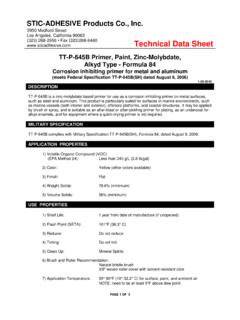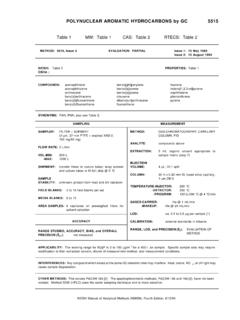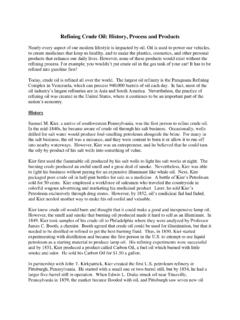Transcription of STIC-ADHESIVE Products Co., Inc. Transport …
1 STIC-ADHESIVE Products Co., Inc. Transport Emergency (Chemtrec): (800) 424-9300 3950 Medford Street, Los Angeles, California 90063 (323) 268-2956 Fax (323) 268-6480 CAGE Code: 1BH90 MSDS Date: 06/2011 MSDS No.: MIL-DTL-24441D3-F150-III-v2 PAGE 1 OF 4 MATERIAL SAFETY DATA SHEET SECTION 1: product Identification TECHNICAL DESCRIPTION: MIL-DTL-24441D, meets Federal Specification MIL-DTL-24441D, dated August 27, 2009 product NAME: PAINT, EPOXY-POLYAMIDE, TWO COMPONENT SYSTEM (Component "A") TYPE: Type III, MIL-DTL-24441/20B(SH) - Green Primer, Formula 150, Component "A" - Polyamide SKUs: 24441-F150-T3-GL-A, 24441-F150-T3-CN-A SECTION 2: Hazardous Ingredients % by Weight Exposure Limits in Air Chemical CAS Number ACGIH (TLV) OSHA (PEL) Polyamide Polyamide Adduct Thixatrope Agent Magnesium Silicate n-Butyl Alcohol Titanium Dioxide * - respirable fraction Trade secret 68953-09-3 Trade secret 14807-96-6 71-36-3 13463-67-7 1 -- 2 22 -- 26.
2 5 -- 2 40 -- 45 20 -- 24 7 -- 10 NA NA 20 mppcf (dust) TWA 2mg/m3* TWA 20 ppm TWA 10mg/m3 TWA NA NA 20 mppcf (dust) TWA 20 mppcf (dust) TWA 100ppm TWA 15mg/m3 TWA (total dust) SECTION 3: Physical/Chemical Characteristics APPEARANCE & ODOR: colored viscous liquid, solvent odor VOC (Volatile Organic Content): 340g/L ( ) admixed 1:1 by volume with component B (maximum) VAPOR PRESSURE: mmHg at 68 F (for N. Butanol) BOILING RANGE: 241 246 F (116 119 C) at 760 mmHg WT/GAL .: Lbs. SPECIFIC GRAVITY: VAPOR DENSITY: NA (Air = 1) SECTION 4: Fire and Explosion Hazard Data HMIS: H-3* F-3 R-0 PE-F US DOT Category: Flammable Liquid Flashpoint (TCC): 97 F (36 C) Hazard Class: 3 Explosive Limit: N. Butanol UEL: ID No.
3 : UN-1263 Packaging Group: III EXTINGUISHING MEDIA: Use National Fire Protection Association (NFPA) Class B extinguishers (carbon dioxide, dry chemical, or universal aqueous film forming foam) designed to extinguish NFPA class IC flammable liquid fires. UNUSUAL FIRE AND EXPLOSION HAZARDS: May generate toxic or irritating combustion Products . Vapor forms explosive mixtures with air. Most vapors heavier than air. May generate Carbon Monoxide gas. SPECIAL FIRE FIGHTING PROCEDURES: Water spray may be ineffective. Water spray may be used to cool closed containers to prevent pressure build-up and possible auto ignition or explosion when exposed to extreme heat. If water is used, fog nozzles are preferable.
4 Fire fighters should wear self-contained breathing apparatus and chemical-resistant, personal protective equipment. SECTION 5: Reactivity Data STABILITY: Stable HAZARDOUS POLYMERIZATION: Not expected to occur. HAZARDOUS DECOMPOSITION OR BYPRODUCTS: (from burning, heating or reaction with other materials). Carbon Monoxide in a fire. Carbon Dioxide in a fire. INCOMPATIBILITY (Materials and Conditions to Avoid): Avoid contact with oxidizing agents ( Perchlorates, nitrates, etc), reactive metals ( sodium, calcium, zinc ext.), sodium, calcium hypochlorite, and heat. Reaction with peroxides may result in violent decomposition of peroxides possibly creating an explosion. Material reaction with hydroxyl compounds. SECTION 6: Spill or Leak Procedures STEPS TO BE TAKEN IN CASE MATERIAL IS RELEASED OR SPILLED: Absorb liquid with vermiculite, floor absorbent or other absorbent material and transfer to hood.
5 Eliminate all ignition sources (flares, flames including pilot lights, electrical sparks). Persons not wearing protective equipment should be excluded from area of spill until clean-up has been completed. Stop spill at source. Prevent from entering drains, sewers, streams or other bodies of water. Prevent from spreading. If runoff occurs, notify authorities as required. Pump or vacuum transfer spilled product to clean containers for recovery. Absorb unrecoverable product . Transfer contaminated absorbent, soil and other materials to containers for disposal. WASTE DISPOSAL METHOD (Small Spill): Allow volatile portion to evaporate in hood. Allow sufficient time for vapors to completely clear hood duct work.
6 Dispose of remaining material in accordance with applicable regulations. (Large Spill): Incinerate in approved facility. Dispose in accordance with local, state and federal regulations. MATERIAL SAFETY DATA SHEET MSDS No.: MIL-DTL-24441D-F150-III-v2 PAGE 2 OF 4 SECTION 7: Health Hazard Data ROUTES OF EXPOSURE: Eye contact, skin contact, inhalation. HEALTH HAZARDS: Eye irritant. Respiratory tract irritant. Skin irritant. May cause skin sensitization. May cause central nervous system depression. ACUTE EFFECT: Contact with skin may cause dryness, itching and/or rash. Inhalation of mists or vapors may cause irritation in the respiratory tract. Contact with the eyes causes severe eye irritation.
7 product is absorbed through the skin and may cause nausea, headache and general discomfort. LONG TERM EXPOSURE: Repeat or prolonged exposure may result in adverse respiratory effect (such as cough, tightness of chest or shortness of breath), adverse eye effect (such as Conjunctivitis, or corneal damage). Repeated exposure to vapors may cause sore throat and eye irritation. MEDICAL CONDITIONS GENERAL AGGRAVATED BY EXPOSURE: May cause allergic skin reaction/sensitization. SIGNS AND SYMPTOMS OF OVEREXPOSURE: Symptoms from inhalation, eye or skin exposure, or absorption through skin may include: stomach or intestinal upset (nausea, vomiting, diarrhea), redness and itching, irritation (eye, nose, throat, airways), or central nervous system depression (dizziness, drowsiness, weakness, fatigue, nausea, headache, unconsciousness).
8 CARCINOGENICITY: This product does not contains known carcinogens in concentration of percent or greater under OSHA, NTP, or IARC. SECTION 8: First Aid Procedures INGESTION: If swallowed seek immediate medical attention. If individual is drowsy or unconscious do not give anything by mouth. Do not induce vomiting unless directed to do so by medical personnel. Do not leave individual unattended. EYE CONTACT: In case of eye contact, flush eyes immediately with plenty of water for at least 15 minutes. Seek immediate medical attention. SKIN CONTACT Remove contaminated clothing. Flush exposed area with large amount of water, launder clothing before reuse. If skin is irritated, seek immediate medical attention.
9 INHALATION: If affected by inhalation of vapor or spray mist, remove to fresh air. Apply artificial respiration and other supportive measures as required. If symptoms develop, seek medical aid. OTHER: If ingested or symptoms of overexposure occurs, contact a poison control center (800) 854-6813, emergency room or physician immediately; have Material Safety Data Sheet information available. SECTION 9: Protection Information RESPIRATORY PROTECTION: If workplace exposure limit(s) of product or any component is exceeded (see section II), a NIOSH/MSHA approved air supplied respirator is advised in absence of proper environmental control. OSHA regulations also permit other NIOSH/MSHA respirators (negative pressure type) under specified conditions (see your industrial hygienist).
10 Engineering or administrative controls should be implemented to reduce exposure. VENTILATION: Provide sufficient mechanical (general and/or local exhaust) ventilation to maintain exposure below TLV(s). PROTECTIVE GLOVES: Wear gloves resistant to chemicals listed in Section 2. EYE PROTECTION: Chemical splash goggles in compliance with OSHA regulations are advised; however, OSHA regulations also permit other type safety glasses. Consult your safety representative. OTHER PROTECTIVE EQUIPMENT: To prevent repeated or prolonged skin contact, wear impervious clothing and proper footwear. SECTION 10: Special Precautions HANDLING: Avoid contact with skin or eyes, avoid breathing vapors.







